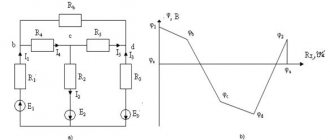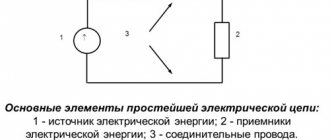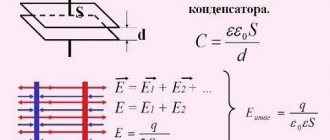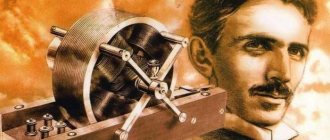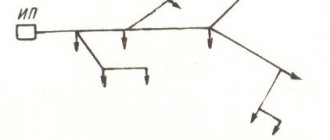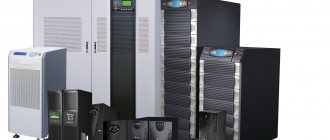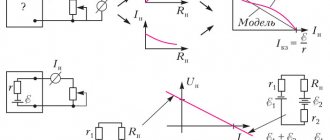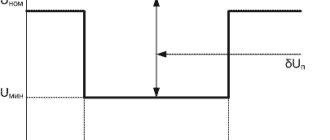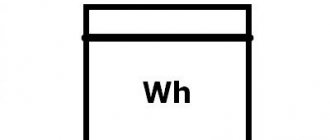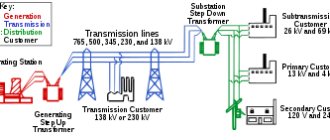A source of electrical energy is an electrical product (device) that converts various types of energy into electrical energy at power plants .
The fuel for power plants is natural resources - coal, peat, water, wind, sun, nuclear energy, etc.
Depending on the type of energy being converted, power plants can be divided into the following main types: thermal, nuclear, hydroelectric power plants, pumped storage, gas turbine, as well as low-power local power stations - wind, solar, geothermal, tidal, diesel, etc.
- A thermal power plant (TPP) converts heat energy into electricity. Thermal power plants operate on fossil fuels - fuel oil, coal, peat, gas, shale (Fig. 1)
- A hydroelectric power plant (HPP) converts the energy of water movement into electricity. Hydroelectric power plants are built in places where large rivers are blocked by a dam, and using the energy of falling water, they rotate the turbines of an electric generator. There are dam and diversion types of hydroelectric power stations.
- Nuclear power plants (NPPs) differ from a conventional steam turbine station in that nuclear power plants use the fission process of uranium, plutonium, thorium, etc. nuclei as an energy source (Fig. 1).
Figure 1 - Power plants: a-thermal (TPP); b-dam hydroelectric power station; v-atomic
Non-traditional energy sources will become the main ones by 2050, scientists say, and traditional ones will lose their need.
- Solar energy (Fig. 2) is widely used for both heating water and generating electricity. Solar collectors are made from available materials: steel, copper, aluminum, etc., that is, without the use of scarce and expensive silicon. This allows you to significantly reduce the cost of equipment and the energy produced by it. Currently, solar water heating is the most effective way to convert solar energy.
- A wind power plant (WPP) (Fig. 2) converts wind energy into electrical energy.
- Tidal power plants are based on the use (Fig. 2.) of tidal energy.
- Unconventional geothermal energy sources (Fig. 2) are based on the use of heat from earth turbines (deep hot springs).
- Biochemical power plant (Fig. 2). New promising energy sources – biomass.
Figure 2 - Non-traditional energy sources: a – solar panels; wind power plant; tidal power station; geothermal power plant; d-biochemical power plant using biomass
According to the rules for the construction of electrical installations (PUE), there are three categories that differ in the degree of reliability and protection of electrical receivers.
The first category implies a continuous supply of electricity to objects and does not allow interruptions in power supply. Interruptions in the supply of current can lead to very serious consequences, namely:
- threat to human life and health;
- significant financial losses;
- breakdown of expensive equipment, violation
- functioning of housing and communal services facilities;
- failure in technological processes, etc.
Electric receivers of the first category are widely used in industry (chemical, metallurgical), mines, medical institutions and intensive care units, boiler rooms, fire-fighting devices, elevators, etc.
The second category of electrical receivers includes devices, the disconnection of which can lead to the following consequences:
- disruption of the production cycle and under-supply of products;
- downtime of equipment, transport and various mechanisms;
- disrupting the life of entire areas and large numbers of people.
The second category of power supply to electrical receivers includes residential multi-apartment buildings, dormitories, children's and medical institutions, sports facilities, shops, catering establishments, schools, museums, bathhouses, etc.
The third reliability category includes installations that cannot be classified into the first two groups. These can be residential apartment buildings, small production sites and auxiliary workshops. Power is supplied from a single source, and interruptions in energy supply can reach up to 24 hours (72 hours per year).
Principles of Electrical Energy Generation
The source of electrical energy at stations is machine generators (Fig. 3).
Figure 3 - Generator with designation of its main elements
They convert mechanical energy into electrical energy.
The operating principle of the alternating current generator is based on the law of electromagnetic induction (Figure 4).
Figure 4 - Operating principle of an alternating current generator : F-force rotating the frame, I-current flowing in the frame, S-frame area
Depending on the type of prime movers, power plants are divided into thermal, hydraulic and wind power.
Despite the differences in the design of the power plant and the method of conversion into electrical energy, the principle of operation is almost the same for all. The figures in Appendix 1 show diagrams of the operating principle of commonly encountered power plants.
Most power plants are interconnected into energy systems . With rapidly increasing load, fast-starting steam turbine units, as well as diesel units, may be required.
Short-term interruptions in power supply may occur when power is restored by automatic reclosing (AR) and automatic transfer switching (ATS) devices. Therefore, for electrical receivers that do not allow power interruptions at all, highly reliable autonomous local sources are used.
The following are used as local sources of reactive power:
- synchronous generators of factory thermal power plants and other regularly operating factory power plants and generator sets;
- synchronous motors with cosφ 0.9;
- capacitor banks.
The power sources for workshop electrical receivers are workshop transformer substations (TSS). The number of transformers at the central heating substation is chosen to be one or two.
Receipt, transmission and distribution of electrical energy in the national economy of the country
| Item: | Physics |
| Kind of work: | Essay |
| Language: | Russian |
| Date added: | 07.07.2019 |
- This type of work is not scientific work, it is not a finished work!
- This type of work is a finished result of processing, structuring and formatting collected information intended for use as a source of material for independent preparation of educational work.
If you have a hard time understanding this topic, write to me on WhatsApp, we’ll look into your topic, agree on a deadline, and I’ll help you!
At this link you can find many ready-made topics for physics essays:
| Lots of ready-made physics essays |
Check out these similar threads, they might be useful to you:
| Electromagnetic induction. Experiments. Application |
| Harmonic oscillation. The equation. Self-oscillations. Mechanical resonance |
| The device of a simple radio receiver. Principles of Cellular Communication |
| Complete reflection of light. Total reflection prisms |
Introduction:
One of the most important indicators of the level of technical development of any country is the level of development of its energy sector. Modern energy is mainly electricity, i.e. the production and consumption of electrical energy determine the level of development of the state.
Electrical energy is used in all sectors of industry, construction, transport and agriculture due to a number of properties unique to it: it can be transmitted over long distances, and also converted into other types of energy - mechanical, thermal, chemical.
Basic information about electrical energy
The ability to transmit electrical energy over distances reaching several hundred and even thousands of kilometers determines the construction of power plants near fuel refueling sites or in high mountain rivers, which is more economical than transporting large amounts of fuel to power plants located near electricity consumers.
The ability to convert electrical energy into mechanical energy using electric drives, i.e. the use of electric motors, which are structurally simple and easy to operate, instead of bulky and complex steam engines and internal combustion engines, makes it possible to more efficiently use the production capacity of enterprises, reduce operating costs and automate production processes. That is why modern industrial enterprises are saturated with electric motors with power ranging from several watts to several hundred and even thousands of kilowatts. The scale of use of electric motors is evidenced by the fact that they currently consume more than 50% of all electricity produced in the country. Electricity is widely used not only in industry, but also in transport: it powers trains, trams, trolleybuses and even cars.
However, the role, possibilities and scale of the use of electrical energy will not be fully characterized if we do not talk about its use in the technologies of various industries: it is used for welding steel, welding and cutting metals, and the use of persistent anti-corrosion agents. coatings on metal surfaces, etc.
The role of electricity in automation and telecontrol of production processes is irreplaceable. Here, no type of energy known to modern science can completely replace electrical energy.
Types and main characteristics of power plants
Power plants generate electrical energy, which, depending on the energy carriers used in them, is divided into thermal (steam turbine), nuclear (reactor) and hydroelectric (hydraulic turbine). There are also power plants that use wind and heat from the sun, but these are low-energy sources of electricity intended only to supply energy to individual small consumers located far from large power plants and system networks.
Thermal power plants (TPPs) use thermal energy obtained by burning coal, peat, oil shale, fuel oil or natural gas in boiler furnaces.
At a thermal power plant, water in the boilers is converted into steam, which enters the steam turbine through a steam line and drives its rotor, as well as the generator rotor mechanically connected to it. In a generator, mechanical energy is converted into electrical energy and the generator becomes a source of electrical current. Thus, the thermal energy of the steam is converted into mechanical energy of rotation of the turbine, which in turn is converted into electrical energy.
The conversion of energy from one type to another is inevitably accompanied by losses, which depend mainly on the method of conversion, as well as on the perfection and condition of the converting devices.
The exhaust steam, having passed through all stages of the turbine, enters the condenser, where, when cooled, it turns into condensate, which is again pumped into the boiler. The return of clean condensate reduces the formation of scale in boilers and thereby increases their service life. Thus, a thermal condensing power plant (CES) operates in a closed cycle, providing consumers only with electrical energy.
Thermal condensing power plants have low efficiency (30 ... 40%), since most of the energy is lost in the flue gases and condenser cooling water. It is advantageous to build IES in close proximity to fuel production sites. At the same time, electricity consumers may be located at a considerable distance from the station.
Providing consumers with not only electrical, but also thermal energy is carried out by a thermal power plant (Fig. 1.b), which is called a thermal power plant (CHP). In it, the cycle described above converts thermal energy into mechanical and then into electrical energy, but a significant part of the thermal energy in this case is supplied in the form of hot water and steam to consumers located in close proximity to the power plant.
The efficiency of thermal power plants reaches 60 ... 70%. Such stations are usually built near consumers - industrial enterprises or residential areas. Most often they run on imported fuel.
The thermal power plants under consideration are steam turbine stations based on the type of the main thermal unit (steam turbine unit - STU). Thermal power plants with gas turbine (GTU), combined cycle gas (CCGT) and diesel (DU) units are much less widespread.
A nuclear power plant (NPP) is essentially a thermal power plant, differing from the latter only in that it uses a nuclear reactor with a heat exchanger instead of a boiler plant and uses the heat generated by the fission process of uranium nuclei or plutonium atoms. Nuclear power plants are widespread in Russia because they can be built in areas remote from natural fuel sources or lacking hydropower resources. One of the main advantages of nuclear power plants is the low consumption of fuel consumed, and, consequently, a sharp reduction in the cost of its transportation.
The world's first nuclear power plant, which converts the fission energy of atomic nuclei of heavy elements into electrical energy, was built in 1954 in the Soviet Union in the city of Obninsk. The main thermal unit of a nuclear power plant, like a thermal power plant, is a steam turbine unit. Water vapor also serves as a medium that converts thermal energy into mechanical energy. The fundamental difference between a nuclear power plant and a thermal power plant is that the heat required to generate steam is obtained not by burning fuel, but by fissioning the nuclei of heavy elements in nuclear reactors. Such elements are the natural isotope uranium-235 or isotopes obtained artificially from uranium-233 and plutonium-239. From 1 kg of uranium you can get the same amount of heat as burning about 3000 tons of coal.
Over the years since the commissioning of the first nuclear power plant, several nuclear reactor projects have been created, on the basis of which the widespread development of nuclear energy in our country began. Nuclear power plants are classified by the type of reactor and the number of circuits through which the generated heat can be transferred to the working fluid (steam) of the steam turbine. The thermal circuit of a nuclear power plant can be two- or three-circuit. In the three-circuit scheme of the first circuit, the radioactive coolant heated in reactor 1 enters the steam generator 6, where it transfers heat to the working fluid (steam) and returns to the reactor using circulation pump 5. In the second circuit, the steam rotates through the intermediate heat exchanger 8 and turbine 2 generator 3, and then through condenser 4 using pump 9 it returns to the heat exchanger (third circuit). Thus, in a three-circuit nuclear power plant, the primary coolant circuits, which can be water and a steam-water mixture, and the working fluid (steam), are separated. In this scheme, the radioactive circuit does not include all the equipment, but only part of it, which simplifies operation.
Ensuring radiation safety of personnel and the population, which is the most important task in the operation of a nuclear power plant, is achieved through the creation of special structures and protective devices, water and air purification, removal and reliable localization of radioactive contamination.
Hydroelectric power plants (HPPs) are built on rivers using the pressure of water flow, artificially created by the difference in its levels on either side of the dam.
To ensure reliability of power supply to consumers and more complete use of the power of power plants operating in different modes, they are combined into electric power systems.
The idea of a system for the production, transmission and distribution of electrical energy is given by the diagram of power supply to consumers shown in Fig. 4. Electrical energy generated by generators in a power plant is transmitted at a voltage higher than the generator voltage through a high-voltage power line to the substation of an industrial plant. Transformers are used to change the voltage in the system. From the substation busbars, electricity is distributed among various electrical consumers: electric motors, light sources, heaters, etc.
The production of electrical energy and its consumption are continuous and time-unified processes. Electrical energy cannot be accumulated in large quantities without being transferred to consumers, that is, at each moment its production must correspond to consumption. Individual power plants cannot provide an uninterrupted supply of electricity to consumers, so as the electric power industry develops, they are combined into systems in which they operate in parallel for a common load.
Integration of power plants into energy systems is of great importance to ensure coordinated operation of different types of plants, especially thermal and hydroelectric power plants. The capacity of hydroelectric power plants is different during floods and in winter, so in the spring the main load in the energy system is carried by hydroelectric power plants, while at thermal stations some of the main units are shut down, which ensures fuel savings and scheduled repair work. In winter, the role of thermal and hydroelectric power plants changes. Thus, it becomes possible to create cost-effective operating modes for various types of power plants.
The creation of power systems increases the reliability of power supply and improves the quality of electricity, ensures constant voltage and frequency of the generated current, since fluctuations in consumption are perceived simultaneously by many power plants.
The energy system (energy system) is a set of power plants, power lines, substations and heating networks interconnected by the general mode and continuity of the processes of production and distribution of electrical and thermal energy.
The electrical system is part of the power system and consists of generators, switchgears, electrical networks (substations and power lines of various voltages) and power receivers.
Energy systems (electrical systems) also include manufacturing plants and workshops, laboratories and lifting machines necessary to perform work related to the operation of all elements of these systems.
The operation of the energy system is carried out by engineers, technicians, foremen and workers of appropriate qualifications. Operational control of the power system (electrical system) is provided by dispatchers, maintenance of equipment at power plants and substations is carried out by on-duty personnel, and power lines are carried out by line personnel.
The energy systems of individual regions, interconnected by power lines, form integrated energy systems (for example, the Ural, Siberian, Central, North-Western, etc.). The unification of a number of energy systems (Ural, Southern, Central, etc.) created the Unified European Energy System of Russia.
Basic information about installations that transmit, distribute and consume electricity
The generated electrical energy enters the place of consumption through a system of interconnected transmission, distribution and conversion electrical installations. Electricity is transmitted through overhead power lines with voltages ranging from several hundred to hundreds of thousands of volts. Electrical energy is transmitted through system overhead networks with voltages of 35, 110, 150, 220 kV and higher according to the rated voltage scale established by GOST. Electrical power distribution is carried out using power center (CPU), distribution points (RP) and distribution lines (RL).
The energy center refers to the switchgear (RU) of the power plant's voltage generator or the secondary voltage of the power system's step-down substation with a voltage regulator to which the district's distribution networks are connected.
A distribution point is a substation of an industrial enterprise or city electrical network, designed to receive and distribute electricity at one voltage without converting it.
A distribution line is a line that supplies several transformer substations from the CPU or switchgear or inputs for consumer electrical installations.
A substation is an electrical installation that serves to convert and distribute electricity and consists of transformers or other power converters, switchgear up to 1000 V and above, batteries, control units and auxiliary devices.
Electricity is supplied to industrial, urban and rural consumers from transformer substations, the main element of which is a transformer, which converts (converts) electrical energy of one voltage into electrical energy of another (higher or lower voltage). A schematic diagram of the transmission and distribution of electrical energy is shown in Fig. 5. Electrical energy generated by generators with a rated voltage of 10 ... 15 kV is supplied to the transformers of power plant A, where its voltage increases to 220 kV, after which it is supplied to the buses of the open substation of this power plant, and then through the 220 kV power line transmitted to 220 kV buses of the step-down substation, also connected to 220 kV power lines using power. station B.
At the step-down substation, the voltage of electrical energy from 220 kV is reduced by transformers to 10 (or 6) kV, and with this voltage it is supplied to the distribution point, and from it to the PSI, PS2, PSZ substations with power transformers, which in turn reduce the voltage to 380 (or 220) V, i.e. up to the values at which electricity is supplied to consumers.
Electrical energy is used: in electric motors for motor purposes; in incandescent and fluorescent lamps for lighting; in electric furnaces, galvanic baths and various devices for ensuring technological processes; in electric welding installations for welding metals and for other purposes.
When electrical energy is consumed, a reverse conversion process occurs: in electric motors, electrical energy is converted into mechanical energy; in incandescent lamps - first into power, and then into the energy of the light flux; in electric heating furnaces - in thermal ones, etc. These transformations are also accompanied by losses, mainly in the form of heat radiated into the environment.
The production, transmission and consumption of electrical energy are carried out at certain voltages established by GOSTs. For electric motors and various electrical apparatus, the rated voltages are those for which their insulation is designed and at which their normal operation is guaranteed, as guaranteed by the manufacturer. The rated voltage of electrical equipment must be indicated in its passport (for electric motors, devices) or stamp (for relays, devices, etc.). Connecting devices and apparatus to a network with a voltage corresponding to their rated voltage is a mandatory requirement that guarantees the safety of the insulation and the normal life of this electrical equipment.
The rated voltage determines the normal operation of electrical equipment. So, on the lamp or base of an incandescent lamp it is indicated that it is designed for a voltage of 220 V. This means that if it is connected to a network with a voltage of 220 V, it will create a normal luminous flux for this and will work for a long time, guaranteed by the manufacturer. If the mains voltage is less than the rated voltage of the lamp, then its service life will increase slightly, but the luminous flux will decrease sharply, and vice versa, if the mains voltage increases above the rated lamp, it will give more light, but its service life will be many times shorter. The operation of electric motors is affected by the supply voltage as follows. If the voltage rises above the rated motor windings, they become excessively hot and there is a risk of insulation damage. If the electric motor operates at reduced voltage, then its rated power is significantly reduced, which ultimately also leads to overheating of the windings.
From the point of view of energy supply, a modern industrial city with a population of several thousand people presents a huge number of energy receiving devices. There are machines at industrial enterprises, urban electric transport, street lighting, houses, educational, commercial, cultural institutions, etc. A break in the power supply is undesirable for any consumer, but for some consumers it is a break. in a power supply this is still acceptable for a short time, then for others it should be completely ruled out. For example, a short-term interruption of power supply to facilities, such as industrial enterprises with automatic lines, metallurgical plants, mines, chemical plants, causes great economic damage, can lead to enormous damage to the product, equipment failure, and even pose a danger to humans. health and life. , A power outage in a residential building only creates certain inconveniences for its residents.
According to the degree of required reliability of power supply, all consumers of electrical energy are divided into three categories, which determine the required number of electricity sources and the power supply scheme.
The first category includes consumers whose power outages could result in danger to human life, significant damage to the national economy, damage to expensive basic equipment, mass refusal of products, and disruption of the functioning of critical elements of public services. These consumers must receive electricity from at least two independent and mutually redundant energy sources.
The second category of consumers consists of electricity consumers whose power outages lead to insufficient production, massive downtime of workers, machines and industrial vehicles, as well as disruption of the normal activities of a significant number of people. These consumers can receive electricity from two independent sources. In the event of a power failure at one of them, let us interrupt the power supply for the time necessary for the on-duty personnel or field task force to turn on the backup power.
All other electricity consumers belong to the third category. Power supply to these consumers is allowed from one source.
For the normal operation of any electricity consumer, not only uninterrupted power supply is required, but also a certain quality of electrical energy, indicators of which include: deviations of voltage and frequency from the specified nominal values, fluctuations in voltage and frequency, non-sinusoidal shape of the voltage curve, asymmetry of the three-phase voltage system.
The deviation of the current frequency is the difference between the actual value of its frequency and the nominal value in an interval of 10 minutes. This deviation should not exceed 0.1 Hz. In addition, current frequency fluctuations of no more than 0.2 Hz/s are permissible. To maintain a constant current frequency, additional generators are used if necessary or unloading the electrical system, if necessary, by limiting the use of electricity or disconnecting consumers from the third group from the source.
Permissible voltage deviations for different consumers are different. So, for example, for lamps they are 2.5 ... 5% of the nominal value, for electric motors - 5 ... 10%, and for other consumers - 5%.
To limit voltage fluctuations, the voltage levels of power transformers at substations are switched, parallel transformers, lines and power plant generators are switched on or off for parallel operation.
A large amount of fuel and various technical means are spent on the production, transmission and distribution of electrical energy, as well as the labor of a large number of people involved in the operation and repair of electrical networks of stations and substations, so this must be spent economically.
There are many ways to save energy. For example, in industry this can be achieved by reducing the idle speed of machines, normal load on electric motors, good care of electrical equipment (timely replacement of grease in bearings, high-quality repair of electric motors), correct technological processes, etc. Significant energy savings on lighting can be achieved through the correct choice of luminaire designs and installed lamp power, timely cleaning of fittings and lamps from soot and dust. Almost every consumer has his own energy saving capabilities and reserves, which must be identified and used in the interests of the consumer and the national economy.
Power station
Classification of premises according to environmental conditions
The basic principles of organization and requirements for the installation of electrical installations are regulated by the Rules for the Installation of Electrical Installations (PUE) and Construction Norms and Rules (SNiP), as well as installation instructions, technological rules and manufacturers' instructions. ,
The PUE lists the requirements for electrical networks and batteries; the rules for selecting conductors for heating and economic current density, as well as electrical devices and apparatus for short-circuit conditions are indicated; general requirements and guidelines for the installation of electrical installations, guidelines for ensuring safety during the installation and operation of electrical devices, scope and standards for acceptance testing of electrical installations.
SNiP provides standards and basic technological parameters and installation rules for all types of electrical devices; determines general requirements for the organization of work, requirements for design and technical documentation, as well as for buildings and structures adopted for the installation of electrical equipment; Other issues of organizational and technical preparation of installation work are considered. In addition, the requirements for the supply of equipment, the procedure and conditions for its acceptance, storage and delivery for installation are indicated.
The normal operation of electrical installations depends on various environmental factors. Electrical networks and electrical equipment are affected by ambient temperature and its sudden changes, humidity, dust, vapors, gas, and solar radiation. These factors can change the life of electrical equipment and cables, deteriorate their operating conditions, cause accidents, damage and even destruction of the entire installation. The electrical properties of insulating materials, without which no electrical device can do, especially depend on environmental conditions. Under the influence of climate and even weather changes, these materials can quickly and significantly change, and in critical conditions they lose their electrical insulating properties.
When designing, installing and operating electrical installations, it is necessary to take into account the influence of adverse environmental factors on electrical equipment. Requirements for the protection of electrical equipment and cable products from the effects of adverse factors during storage, installation and operation are set out in the EMP and SNiP.
Depending on the nature of the environment and the requirements for protecting electrical installations from its influence, PUE distinguishes between indoor and outdoor installations. In turn, the internal part is divided into dry, wet, damp, especially wet, hot, dusty, with a chemically active environment, fire hazardous and explosive, and external (or open) installations - ordinary, fire hazardous and explosive. Electrical installations protected only by canopies are classified as external.
Rooms in which the relative humidity does not exceed 60% are considered dry. If in such rooms the temperature does not exceed 30 ° C, there is no technological dust, active chemical environment, fire or explosive substances, then they are called rooms with a normal environment. Wet rooms are characterized by a relative humidity of 60 ... 75% and the presence of vapors or condensing moisture, which are released temporarily and in small quantities. Most electrical equipment is designed to operate at a relative humidity of no more than 75%, therefore, normal electrical equipment is used in dry and wet rooms. Wet areas include pumping stations, production workshops where relative humidity is maintained between 60 ... 75%, heated basements, kitchens in apartments, etc.
In wet areas, the relative humidity exceeds 75% for a long time (for example, in some metal rolling shops, cement plants, wastewater treatment plants, etc.). If the relative humidity in the rooms is close to 100%, that is, the ceiling, floor, walls, and objects in them are covered with moisture, then these rooms are considered especially wet.
In some branches of metallurgical and other industries (for example, in foundries, thermal, rolling and blast furnaces), the air temperature exceeds 30 ° C for a long time. Such rooms are called hot. At the same time, they may be damp or dusty.
A room is considered dusty in which, under production conditions, technological dust is formed in such quantities that it settles on wires, penetrates into machines, apparatus, etc.
There are dusty rooms with conductive and non-conductive dust. Dust, which does not conduct current, does not deteriorate the quality of the insulation, but contributes to its moistening and to the current-carrying parts of electrical equipment due to its hygroscopicity.
In rooms with a chemically active environment, in accordance with production conditions, vapors are constantly or for a long time contained or deposits are formed that destroy the insulation and live parts of electrical equipment.
Fire hazardous areas include those in which flammable substances are used or stored. According to the degree of fire danger, they are divided into three classes: PI, P-II, P-IIa. The first class includes premises in which flammable liquids are used or stored, the second class includes premises in which, in accordance with production conditions, suspended combustible dust is released, which does not form explosive concentrations, and the last class includes premises in which flammable substances from solid or fibrous materials - substances that do not form airborne droplet mixtures.
Explosive premises are those in which explosive mixtures of flammable gases or vapors with air, oxygen or other gases - oxidizers of flammable substances, as well as mixtures of combustible dust or fibers with air, when they become suspended, can be formed under industrial conditions.
Explosive installations are divided into six classes according to the degree of danger of using electrical equipment: BI, B-1a, B-IB, B-II, B-II and B-IIa. In class BI installations under production conditions, the formation of explosive mixtures of flammable gases or vapors with air or other oxidizer under normal process conditions may not last long. Class B-1a includes installations in which explosive mixtures of vapors and gases can only be formed in the event of accidents or malfunctions of process equipment. Class B-1b installations are characterized only by the local formation of explosive concentrations of vapors and gases in the air in small volumes with reliable ventilation. Outdoor installations that produce explosive concentrations of flammable gases or vapors are classified as B-II. Explosive concentrations of suspended combustible dust can be created in class B-II installations during normal operation of process equipment, and in class B-IIa installations only in the event of accidents or malfunctions.
Outdoor installations in which flammable liquids or solid combustible substances are handled or stored (outdoor storage areas for mineral oils, coal, peat, wood, etc.) are classified as fire hazard class P-III.
Premises are classified according to the highest explosion hazard class of the installations located in them. Aggressive, humid, dusty and similar environments not only worsen the operating conditions of electrical equipment, but also increase the danger of electrical installations for the people operating them. Therefore, in the premises of the PUE, depending on the possibility of electric shock, people are divided into three groups: with increased danger, especially dangerous and without increased danger.
Most industrial premises are hazardous, that is, they are characterized by the presence of dampness (relative humidity exceeds 75% for a long time) or conductive dust, conductive floors (metal, earth, reinforced concrete, brick), high temperature (exceeding 30 ° C for a long time ), as well as the possibility of simultaneous human contact with metal structures of buildings connected to the ground, technological devices, mechanisms, on the one hand, and metal buildings of electrical equipment, on the other.
Particularly hazardous areas are characterized by particular dampness or the presence of a chemically active environment or two or more conditions of increased danger.
If the premises do not have conditions that create increased or special danger, they are called premises without increased danger.
Depending on the type of technological activity in premises of various categories and the possibility of electric shock to people in private unitary enterprises, the nature of the operation of electrical equipment used for a given environment, the types and methods of constructing electrical networks are determined.
Conclusion
During the work the following was taken into account:
- Basic information about electrical energy.
- Types and main characteristics of power plants.
- Organization of energy supply.
- Basic information about installations that transmit, distribute and consume electricity.
- Classification of premises according to environmental conditions.
Main components of the electrical network
An electric power network (Fig. 5) is a set of electrical installations for the transmission and distribution of electrical energy, consisting of substations, switchgears, conductors, overhead and cable power lines operating in a certain territory.
Figure 5 - Electrical network and electrical installations for transmission and distribution of electrical energy
All circuits encountered in practice are combinations of individual elements - feeders, mains and branches.
Electrical networks, in turn, are divided into main electrical networks and distribution electrical networks.
Trunk networks include all high-voltage power lines (PTLs), distribution networks include power lines with a capacity below 110 kV. Types of electrical networks are presented in Figure 6.
Figure 6 - Types of electrical networks
The networks are interconnected by transformer and distribution substations. To meet the established requirements, power systems are equipped with special control centers equipped with monitoring, control, communication means and special layouts of power plants, transmission lines and step-down substations.
Electrical networks are divided into:
- tension;
- degrees of mobility;
- purpose;
- type of current and number of wires;
- electrical connection diagram:
a) open (non-redundant). A diagram of open-loop networks is shown in Figure 7.
Figure 7 - Schemes of open-loop networks : a - radial (load only at the end of the line); b - main (the load is connected to the line in different places)
b) closed (redundant) (Fig. 8).
Figure 8 — Schemes of closed networks: a — network with two-way power supply; b - ring network; c - double main line; g complex network (for supplying critical consumers in two or more directions)
Main power supply circuits are used in the following cases:
- a) when the load is concentrated in nature, but its individual nodes are located in the same direction in relation to the substation and at relatively small distances from each other, and the absolute values of the loads of individual nodes are insufficient for the rational use of the radial scheme;
- b) when the load is distributed with varying degrees of uniformity.
By design: electrical wiring (power and lighting), current conductors - for transmitting electricity in large quantities over short distances, overhead lines - for transmitting electricity over long distances, cable lines - for transmitting electricity over long distances in cases where the construction of overhead lines is impossible.
The most widespread for local distribution networks are radial, main, mixed (radial-main) and loop schemes.
With a radial power supply scheme, each line is like a beam connecting a network node (substation, distribution point) with a single consumer.
In the main power supply scheme, one line - the main line - serves, as indicated, several distribution points or receivers connected to it at its various points.
Mixed schemes of local distribution networks are used at different locations of consumers relative to the CPU and combine the principles of constructing both radial and main circuits.
The following requirements are imposed on electrical networks: reliability, survivability and efficiency.
Reliability is the main technical requirement, which refers to the ability of a network to fulfill its purpose within a given time and operating conditions, providing electrical receivers with electricity in the required quantity and proper quality.
The survivability of an electrical network is the ability to fulfill its purpose under conditions of destructive influences, including in a combat situation when exposed to enemy weapons.
Cost-effectiveness is the minimum cost of constructing and operating a network, subject to the requirements of reliability and survivability.
Electricity transmission
Electricity is produced mainly at thermal power plants (TPPs), hydroelectric power plants (HPPs) and nuclear power plants (NPPs).
The rotors of thermal power plant generators rotate due to the energy of burning fuel (most often this fuel is coal). It is economically feasible to build thermal power plants near large coal deposits.
The rotors of hydroelectric power station generators are driven into rotation by the energy of falling water. That's why hydroelectric power stations are built on rivers.
In any case, the problem arises of transmitting the generated electricity to consumers located many kilometers from the power plants.
Electricity is transported through wires. Energy losses due to heating of wires should be minimized. It turns out that this requires high voltage
in the power line. Let's show it.
Let's consider a two-wire power line connecting an alternating voltage source u with a consumer P (Fig. 2).
Fig.2. Transmission of electricity over a two-wire line
The length of the line is , so the total length of the wires will be . If is the resistivity of the wire material and is the cross-sectional area of the wire, then the line resistance will be equal to:
(4)
Power with a given effective value must be transferred to the consumer. Let us denote by and the effective values of voltage in the line and current. If is the phase shift between current and voltage, then, as we know from the previous sheet, .
From here
(5)
Part of the power is lost to heating the wires:
Substituting expressions (4) and (5) here, we get:
(6)
We see from formula (6) that the power loss is inversely proportional to the square of the voltage in the line. Therefore, to reduce losses, it is necessary to increase the transmission voltage. This is why power lines are high voltage
. For example, the Volzhskaya hydroelectric station transmits electricity to Moscow at a voltage of kilovolts.
Power lines
Here it is worth talking about what networks are used to transmit electricity. From the power plant to the end consumer, electricity passes not only through a step-up transformer and high-voltage lines. If you look at a modern city from above, you will notice a whole tangle of wires forming a single network.
To get to the consumer, the current from the high-voltage lines re-enters the transformer, but this time the voltage is reduced. After which it is supplied to the distribution network and distributed to industrial enterprises, which have their own substation to receive the voltage they need, to city substations, which distribute electricity through main cables, and to regional substations.
You might be interested in How to work with heat shrink tubing
City substation
From regional substations through power lines, electricity is supplied to private, apartment buildings and infrastructure facilities. In residential neighborhoods, cables from substations are mostly laid underground, from where they go out to the entrance panel, which then distributes the current to every socket and light bulb in the house.
Power box of a high-rise building
Nuclear power plants
In nuclear power plants, nuclear energy is converted. The main generator is a reactor, from which heat is released during the fission of nuclei of heavy elements. This is carried out through a chain reaction, as a result of which the generation and then transmission of electricity occurs with its distribution. Compared to traditional thermal power plants, nuclear reactors operate not on fossil fuels, but on nuclear energy obtained from plutonium, uranium and other elements. It is noteworthy that the world's reserves of nuclear resources in the form of the mentioned heavy elements exceed the natural volumes of oil, coal, peat and other fossil fuels. This makes nuclear energy very promising, although from the point of view of environmental safety this ratio can hardly be called favorable.
Thermal power plants
It is one of the oldest and most common power generators. Such stations convert thermal energy, which is formed by releasing organic fuel during combustion. But before turning into electricity, chemical fuel energy is converted into mechanical energy. Peat, coal, fuel oil, etc. are used as fuel raw materials. Depending on what kind of electricity transmission is required in a particular area or region, two types of stations can be used. In particular, condensing complexes are intended exclusively for the production of electricity, and combined heat and power plants (CHPs), in addition to electricity, also produce thermal energy, which is often supplied to industrial enterprises.
Electricity readings
Tariffs for this resource may vary depending on various factors. However, the calculation methods are usually the same. Network companies or representatives of the energy generating enterprise take meter readings and then present bills to consumers. But most often, the transmission of electricity readings is carried out by the users themselves. Data is sent to the offices of organizations, sent through online services or dictated over the phone. Each supplier company also provides for debt collection measures.
It is important to note that the calculation of payment amounts may include taking into account planned and actual consumption. After the transfer of data for electricity has been carried out, company representatives draw up a statement, issue an invoice and collect payments.
Receipt
Few ordinary people think about how the electricity that powers the devices and equipment around them is generated. It may surprise many, but energy as an object of matter does not exist - it is nothing more than a force imparted by some objects to others. In nature, similar processes occur all the time. Observing such phenomena, man began to develop ways of purposefully generating and directing energy for specific needs. At the moment, the transmission and distribution of electricity operates as a necessary component of the economic and industrial activities of any state. However, the first stage still remains its production, in which various types of power plants participate.
Hydroelectric power plants
Such stations are a complex of buildings and equipment through which water energy is converted into electricity.
Hydroelectric power plants include a chain of technical structures that provide optimal concentration of water flows and create sufficient pressure. Power equipment is involved in the direct conversion of water flow energy. As a rule, the receipt and transmission of electricity in hydroelectric power plants occurs as a result of the concentration of mechanical force in waterfalls in the operating sections of the dams. The plant's engine room contains hydraulic units, automatic systems for monitoring and control, as well as a central dispatch control post.
